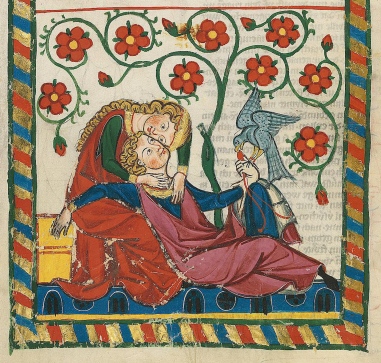Along with physical and spiritual strength, another key element to what made a heroic soldier to the Anglo-Normans was chivalry. Chivalry has three main components that many people tend to look over. These rules are first a knight must be loyal to God, second to his lord, and third to women. In today’s view of chivalry, the last code of conduct towards women is typically the most popular connotation. Although it was third on the list of values, it still plays an extremely large role in heroic literature of the time. One of the best examples of this comes from Marie de France’s lai, “Lanval.”
In this lai, or poem, Lanval, one of King Arthur’s knights, takes up a relationship with a fairy queen who says that he must keep their relationship a secret as long as he wishes her to come to him. Lanval, being loyal to his lover, keeps his word until Queen

Image of Lanval and his lover (“Lanval”).
Guinevere tries to seduce him (de France 179). After refusing the queen, Lanval breaks his oath and reveals his secret lover and insults the queen in doing so. Lanval is not only loyal to his lover because that is his duty as a knight, but he is loyal to her because she offers him wealth, much like a lord would do. In this way, the fairy queen becomes the way in which Lanval progresses the social ladder (Finke and Shichtman 489). Because of this, Lanval is now following all three codes of chivalry to become a heroic knight because the fairy queen is now acting as his lord (or god) and lover.
However, Lanval does betray his oath to his love/lord. This makes readers question in Lanval is the true hero at all in this story. It is, in fact, the fairy queen who rides into the court before Lanval is executed and saves the day (de France 184). With this fact, it could be assumed that the fairy queen is the true hero of the story with today’s view of what makes a hero, but she does not show any feats of physical or spiritual strength nor any chivalry in her mannerisms, not to mention the fact that she is not even a knight at court. Therefore, she would not have been the hero that Lanval would have been to the Anglo-Normans. Lanval proves his heroic knighthood by remaining chaste, a Christian value, to his lover and by showing loyalty to the chivalric code.
Works Cited
de France, Marie. “Lanval.” The Norton Anthology of English Literature. Edited by Stephen Greenblatt, 10th ed., vol. A, Norton & Company, 2018, 171-185.
Finke, Laurie A., and Martin B. Shichtman. “Magical Mistress Tour: Patronage, Intellectual Property, and the Dissemination of Wealth in the ‘Lais’ of Marie De France.” Signs, vol. 25, no. 2, 2000, pp. 479–503. JSTOR, JSTOR, www.jstor.org/stable/3175563.
“Lanval.” Marias Common Place Book. www.sites.google.com/site/mariascommonplacebook/home/lanval, Accessed on 18 Dec. 2018.
